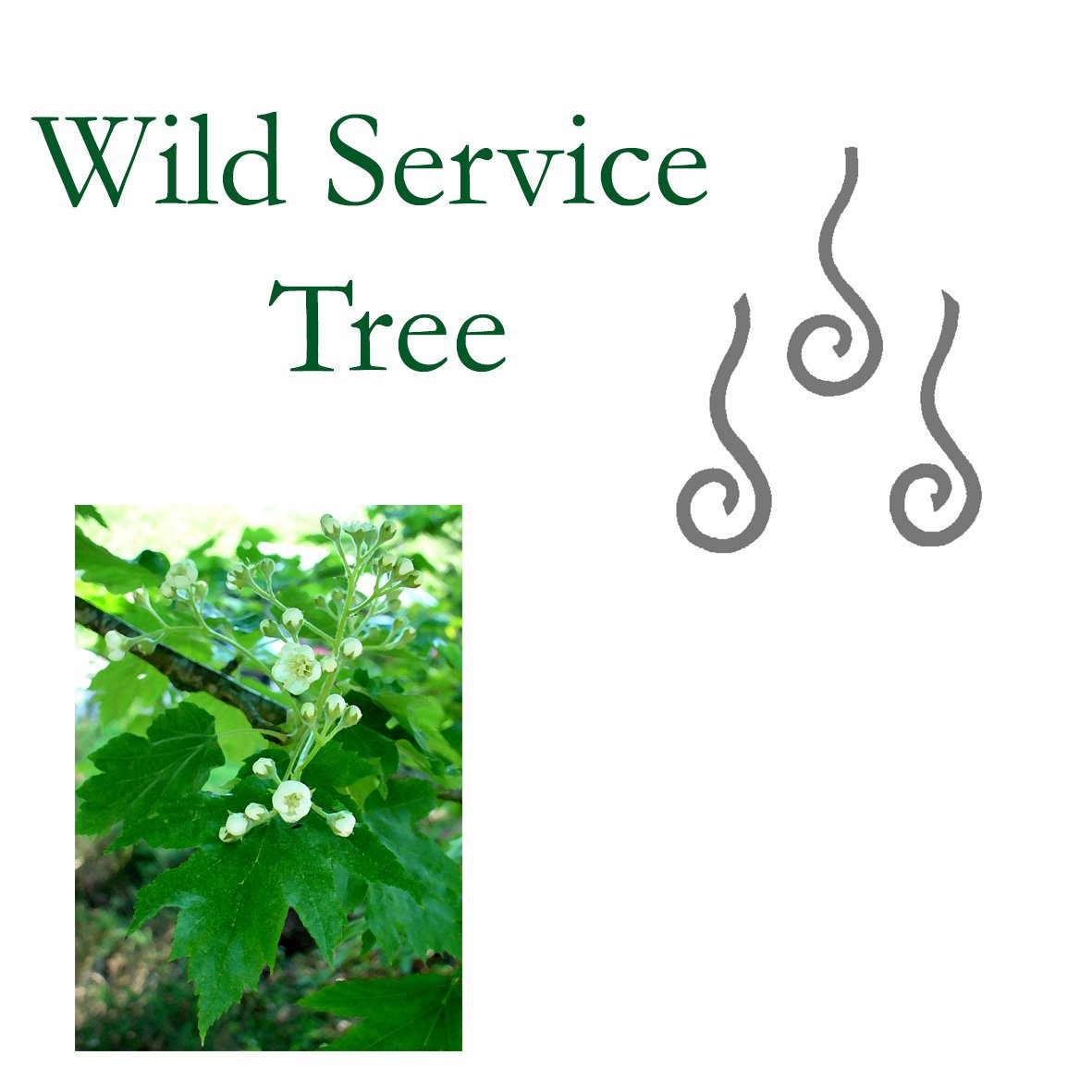Wild Service Tree (Sorbus torminalis)
The wild service tree is a native of the British Isles but these days it is a rare sight, both because it favours ancient woodland and because it superficially resembles a small maple from a distance. The tree is similar to rowan in its shape and form. It is a fairly neat tree with ascending branches making a domed canopy at around 60ft (20m). The young bark is very similar to rowan but when mature the dark grey is broken by shallow cracks more like a maple. The leaves are closely alternate on the branches and so look clumpy from a distance. The leaves are a bright green, quite leathery and smooth, and resemble an elongated maple where the first lobes grow out close to ninety degrees from the leaf-stalk and become more acute as they near the leaf tip. In autumn the leaves turn a stunning ochre, copper and purple red.
Wild service tree flowers in May or June – around the same time as hawthorn whose flower heads it closely resembles. Fruit ripens into clusters of olive-brown or reddish-brown speckled berries. These fruits were a staple of the Neolithic peoples, having a sweet exotic taste after being ‘bletted’ by frost or left to mature once picked. A single tree can produce tons of fruit. The fruits also have a long history of use as a flavouring for alcoholic liqueur. In the far West the tree is known as maple cherry and in the South East as checkers or chequers, possibly after the speckled fruit.
The distribution of wild service tree is very localised in Britain, though more common on Continental Europe. It is found in the remnants of ancient woodland where it tends to spread by vigorous suckering and rarely by seed propagation. It favours clay and limestone and is most numerous on the Weald, reaching from Kent to Hampshire. It can also be found in the Severn and Wye valleys and in the Welsh Marches as well as ancient hedgerows and areas once covered by dense forest, such as the Forest of Arden in Warwickshire. It can be found in the North to about the edges of Cumbria and the Lake District.
The name of the tree some think derives from its Latin name ‘sorbus’, or from the Latin for beer ‘cervisia’. Others reckon the name is probably derived from the Old English word ‘syfre’.
The Essence:
Keywords: “Unfoldment”; expansion of awareness; understanding motives; past life healing; harmony and healing relationship with self and surroundings; quiet, alert, aware; foundation of awareness; source of personal perceptions; self-definition; where we have come from; navigation (knowing the tides and currents of existence); hidden currents.
Wild service tree directs its energy to the expansion of awareness and the growth of clarity. There is a natural tendency to calm fears and restore the balance of mind. This naturally arises where there is a clearer picture about what is driving our behaviour – the reasons why we act or behave in the way we do. Understanding these patterns means they can be directed and controlled in the most appropriate directions.
This tree helps the Heart meridian to correct and balance for an effective deep healing of any long-standing emotional trauma. Such deep patterns or fractures of stress, unless released, set up permanent echoes which have a habit of repeating again and again, so that they can even become tendencies that are carried from life to life. Thus, past life issues and past life emotional trauma can be greatly alleviated by this essence.
Equilibrium and calm also infuses the Gall Bladder meridian and this clarifies our needs and desires. Here too, the essence helps to familiarise ourselves with our internal environment so that we can work more clearly in the external environment of the world.
Emotional stress at the sacral chakra is reduced. There is an increase in peacefulness, which allows personal creativity to emerge. There is also an increase in the ability to express oneself. Minor chakras at the ends of the fingers and toes help us to become more sensitive to the energies around us and allow access and use of healing energies. Wild service tree helps to activate these chakra points in a balanced way. Imbalances here may be indicated by a rejection of other people’s energy or a tendency to unconsciously draw energy from others, leaving them feeling drained.
Wild service tree creates a degree of silence, like a blanket, over emotional noise. It doesn’t prevent or sedate the flow of emotions or of thoughts, but it places the awareness in a state where these are no longer an obstruction to experiencing quietness. Having turned away from the usual noise of the conscious awareness, wild service tree brings a quietness and receptivity to spiritual states that allow a deepening of perception and insight.
Signature:
A retiring tree, quiet in the landscape, very sensitive and particular about its environment, but where it is established it sends numerous vigorous suckers from its roots. Knowing one’s roots, establishes one’s own firm awareness of place and direction.
As an indicator of ancient landscapes it suggests the remembrance of past structures that underlie the present.

